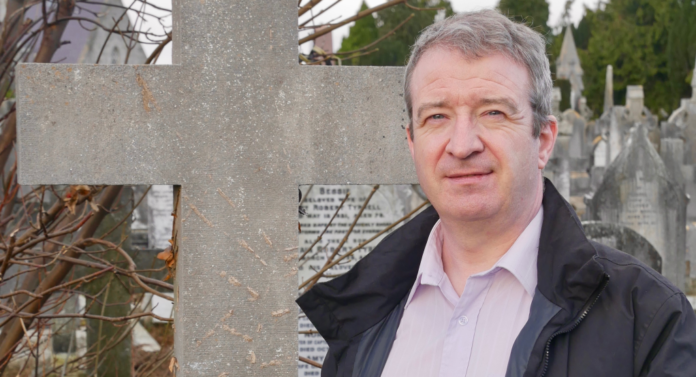David Brady-Browne has written a book on the CofI graveyard in Tulla. Here he explains the value of grave memorials as a substitute record repository for genealogists and historians
ON A mild spring day in 1969, the last burial at the Church of Ireland graveyard in Tulla took place, and with it closed a chapter of the cultural history of East Clare.
Like many old graveyards in Ireland, Tulla is closed to burials but still welcomes visitors. I first visited the graveyard when researching my ancestors buried in it. There they lay, surrounded in death by those who had surrounded them in life. Families such as Molony, O’Callaghan, Brady-Browne, Murdock, Powell and Gore, as well as many others were prominent in the social and commercial life of Tulla for centuries, but their names mean almost nothing to present generations.
There are over 40 identifiable memorials in the graveyard, representing over 70 burials, in addition to around seventy unmarked interments. Many of the older headstones were documented more than a century ago by Clare antiquarian Thomas Johnson Westropp, but his transcripts from that time tell us nothing about the lives of those commemorated. While some of the headstones commemorate “rich men endowed with resources, living peacefully in their great houses,” others give glimpses into the lives of farmers, shopkeepers, police officers, servants and young children. Each headstone hides a story waiting to be told. Many of the headstones pointed the way to significant details about the people buried. In a few cases, almost nothing could be found.
Given the paucity of family history records from 18th and early 19th century Ireland, grave memorials provide a valuable substitute record repository for genealogists and historians, a record of vital events carved in stone. The surviving parish registers for Tulla held at the library of the Representative Church Body in Dublin only contain entries for burials from 1882 to 1969. The civil registers of deaths survive only from 1864, and so the information contained herein includes many burials in the churchyard from 1820 to 1864 not otherwise indexed.
I hope this book will assist those researching the lives of these people, and that it will enhance the enjoyment of anyone who visits the graveyard.
Sixty years ago, The Clare Champion reported that the old Church of Ireland in Tulla had been demolished. (Clare Champion, April 7, 1962, page 10). Another report in The Nenagh Guardian noted:
Workmen began stripping off the roof of the little Protestant church at Tulla on Friday last, which was recently de-consecrated in preparation for its demolition. The church, with its small four-spired tower, presented a picturesque old-world scene. Gone are all the big houses in the locality that up to 40 years ago sent their carriages of worshippers to Service here. The Rectory is now the residence of our local doctor, and the handsome cut-stone stables are used as stores by Clare Co. Council. – The Nenagh Guardian, December 16, 1961, page 9.
Today, only the foundations and vaults of the church building itself remain, together with the boundary walls and a few remnants of masonry scattered about the churchyard. The east window was however saved, and during the renovation of St Kieran’s Church of Ireland in Cloughjordan, County Tipperary, the window was installed in the chancel there in 1969, the same year as the last burial took place in Tulla churchyard.
The old Church of Ireland on Tulla Hill had been in use since 1702, and was built on the site of St Mochulla’s monastery dating from the 4th century. When it fell into disrepair it was proposed to dismantle the church and build another. There was some opposition to this locally, but when the church was struck by lightning, the decision was effectively made.
A site on the Kilkishen Road (now Church Road) was donated by Thomas Browne of Newgrove House, Tulla, and in 1812 a loan of £700 was granted by the Board of First Fruits towards the cost of building the new 200-seat church. The church was completed in 1817-1818 at a total cost of £646 3s. 1d, and was consecrated in 1820.
*David Brady-Browne’s latest book, By Strangers Mourned, The Historic Burials at Tulla Church of Ireland is available to purchase, at a cost of €10, directly from the author by emailing NLTP@eircom.net. The book will also be stocked by The Ennis Bookshop on Abbey Street, Ennis.
In 2015, David published The Brady-Browne Family of Newgrove, County Clare, tracing the family from the 1600s to the 21st century. A few years later, his cousin, Eric Shaw of the Clare Roots Society published a small book on the memorials in St Columba’s Church in Ennis, entitled Memorials of Past Lives. David credits that publication with the idea for his latest book.

